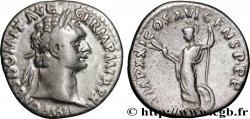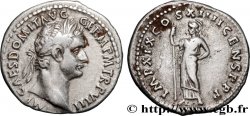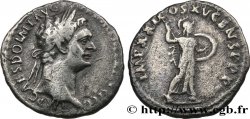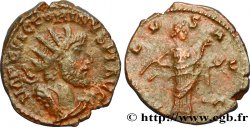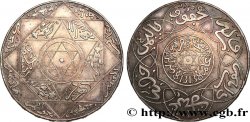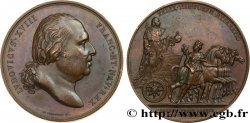v21_2434 - DOMIZIANO As, (MB, Æ 28)
MONNAIES 21 (2004)
Prezzo di inizio : 300.00 €
Valutazione : 600.00 €
Prezzo realizzato : 300.00 €
Numero di offerte : 1
Offerta maxima : 332.00 €
Prezzo di inizio : 300.00 €
Valutazione : 600.00 €
Prezzo realizzato : 300.00 €
Numero di offerte : 1
Offerta maxima : 332.00 €
Tipo : As, (MB, Æ 28)
Data: 81
Nome della officina / città: atelier indéterminé
Metallo : rame
Diametro : 28 mm
Asse di coniazione : 6 h.
Peso : 11,39 g.
Grado di rarità : R1
Commenti sullo stato di conservazione:
Très beau portrait, inhabituel. Patine marron foncé. Joli revers
N° nelle opere di riferimento :
Diritto
Titolatura diritto : IMP CAES DIVI VESP F DOMITIAN AVG P M P P TR P COS VII.
Descrittivo diritto : Tête laurée de Domitien à droite (O*).
Traduzione diritto : "Imperator Cæsar Divi Vespasiani Filius Domitianus Augustus Pontifex Maximus Pater Patriæ Tribunicia Potestate Consul septimum", (L’empereur césar fils du divin Vespasien Domitien auguste grand pontife père de la patrie revêtu de la puissance tribunitienne consul pour la septième fois).
Rovescio
Titolatura rovescio : CERES - AVGVST/ S|C.
Descrittivo rovescio : Cérès voilée et drapée debout à gauche, tenant des épis de la main droite et un sceptre ou une torche de la main gauche.
Traduzione rovescio : “Ceres Augusti”, (Cérès de l’auguste).
Commento
Suivant les ouvrages, ce type est donné à l’atelier de Rome (Sear), à l’atelier de Lyon (pour les auteurs du RIC et du BMC), à un atelier de Bithynie (Giard BN/R). Le style particulier, le choix de la légende de droit pourrait laisser entrevoir une émission très courte et homogène pour le bronze visant à marquer l’accession du nouvel empereur après la disparition de son frère Titus. J.-B. Giard, dans son dernier volume consacré au monnayage de l’atelier rhodanien, ne retient pas ce type monétaire. Le style très particulier pourrait laisser Rome de côté. Alors pourquoi un atelier qui n’aurait fonctionné que trois mois et dans la province de Pont-Bithynie ? La question reste posée, mais sans réponse car ce monnayage reste rare.
Depending on the works, this type is given at the workshop in Rome (Sear), at the workshop in Lyon (for the authors of the RIC and BMC), at a workshop in Bithynia (Giard BN/R). The particular style, the choice of the right legend could suggest a very short and homogeneous issue for the bronze aimed at marking the accession of the new emperor after the disappearance of his brother Titus. J.-B. Giard, in his last volume devoted to the coinage of the Rhone workshop, does not retain this monetary type. The very particular style could leave Rome aside. So why a workshop that only operated for three months and in the province of Pont-Bithynie? The question remains asked, but without an answer because this coinage remains rare
Depending on the works, this type is given at the workshop in Rome (Sear), at the workshop in Lyon (for the authors of the RIC and BMC), at a workshop in Bithynia (Giard BN/R). The particular style, the choice of the right legend could suggest a very short and homogeneous issue for the bronze aimed at marking the accession of the new emperor after the disappearance of his brother Titus. J.-B. Giard, in his last volume devoted to the coinage of the Rhone workshop, does not retain this monetary type. The very particular style could leave Rome aside. So why a workshop that only operated for three months and in the province of Pont-Bithynie? The question remains asked, but without an answer because this coinage remains rare








 Segnalare un errore
Segnalare un errore Stampate la pagina
Stampate la pagina Condividi mia selezione
Condividi mia selezione Fai una domanda
Fai una domanda Consegnare / vendere
Consegnare / vendere
 Descrittivo
Descrittivo
